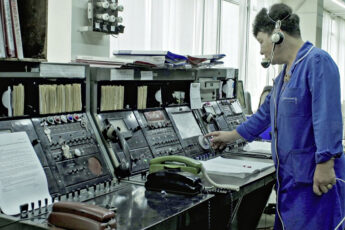Who Plants the Seeds of Evil?
Bartosz M. Kowalski’s Playground (Plac zabaw, 2016)
Vol. 68 (October 2016) by Jack Page
Split into six separate chapters, Playground chronicles a day in the life of three deeply troubled school children. Each segment is more shocking than the last, until the very unspeakable happens. Gabrysia is in love with her classmate Szymek, the best friend of fellow partner in crime Czarek. One day, the two meet Gabrysia after school and brutally assault her. After their unrelenting display of abuse, they travel to the mall where they abduct a wayward toddler. Leading the boy astray to a nearby woodland, they murder the child in the most gruesome possible fashion.
Although perhaps in a more malevolent way, Czarek and Szymek are a perfectly predictable couple of problem children. Their social class as well as their fractured family circles render them both as relatable portrayals of disaffected youth. Their self-aware and self-destructive behavior is visualized in a pivotal moment in the film. Rarely stylized, Czarek and Szymek are shot in slow motion as they march down a heavily populated cobbled street. Every bystander stops in their tracks to gaze disapprovingly at the juvenile delinquents, arms folded and shaking their heads. Unfazed, the boys stroll on by, knowingly shameless and eager to continue their villainous spree of bullying.
When Czarek is introduced, he is intentionally ignoring the cries of his baby brother whom he shares his bedroom with. As the newborn’s wailing reaches a piercing volume from the crib, he merely sits, slumped on his bed, unaffected. A close-up of his furrowed brow and scowling stare informs the audience of his animosity towards the baby. He complains of the incessant noise that prevents him from sleeping soundly to his mother, pleading that the baby’s crib be moved to the corridor of the flat. The curmudgeonly old hag Czarek has for a mother warns her son that he himself might be kicked out of the bedroom altogether. Refusing to lend him money, his teenage brother is equally mean-spirited towards him, mocking his slight lisp and incorrect pronunciation of words. After shaving his head in preparation for the end of school assembly, Czarek makes a trip to the butcher to pick up meat for the household. Instead of completing his mother’s errand and returning the food home, he finds a more sinister use of his time. Upon passing a stray dog searching for scraps amongst a waste disposal site, he teases the mutt with the smell of the raw meat and places it high above the mongrel’s reach on the lid of a dustbin. Using his mobile phone camera, Czarek proceeds to film the dog’s pathetic attempts to leap nearer the food. With a keen focus we have yet to see in the boy, he aims the camera with an air of professionalism, cautious of losing any of the animal’s tragic plight from outside of the frame.
Szymek is given a more misleading opening to the film. Living with his physically and mentally disabled father, he initially possesses the same altruistic nature of any live in caretaker. Providing the patient with lunch, sharing jokes and assisting him with bathroom visits, the boy happily struggles to navigate his father’s wheelchair within their pokey apartment. Assuming the role that has yet to be provided by his mother – an absent parental figure in his chapter – Szymek cooks and cleans in a manner that suggests he has become accustomed to a solitary, domestic lifestyle. Any maternal relationship in his life is reduced to the phone calls he receives from his mother and refuses to accept. But as soon as the film achieves a level of normalcy, the director quickly undermines it, and the once seemingly doting son is shown violently slapping his helpless father without reason or feeling. His confused father yells for aid, pleading for the boy to desist. This scene is interjected by the next shot, where the camera jump cuts to Szymek outside the building smoking a cigarette and avoiding his mother’s calls.
The controversial final chapter dramatizes the harrowing processes that already took place. Czarek and Szymek escape the mall undetected with the little boy, innocently holding his hand so as not to arouse suspicion. By this point in the film, the audience is aware of what Czarek and Szymek are capable of, but they have no knowledge of just how extreme their next measure will be. They walk for a long time, dragging the toddler with them, beating him to continue the journey onward. When they finally arrive by the railroad tracks the child attempts to flee and Czarek kicks him in the head until he begins to crawl across the grass. In a pile of rubble, Szymek picks up a boulder and repeatedly bludgeons the child to death. They throw the corpse onto the railway and cover it with weeds. The sequence is filmed in a single take with a wide angle. The framing of the long shot pushes the action into the distance, almost into the background. Far away from the camera’s lens, their conversation goes unheard by the viewer who can only hear the faint, muffled sobs of the victim and the cracks of his skull against the laughter of Czarek and Szymek. The heightened sense of realism makes for a gut wrenching cinematic experience. The documentary style of cinematography bypasses any dramatic interference such as soundtrack or editing, leaving the audience to be unsuspecting witnesses to the horror on screen. The very last shot of the film is a medium close up of the murderers, revealing details of their clothes, covered in specks of blood. They glare into off-screen space, fatigued but by no means distraught. Along with Czarek and Szymek’s perfunctory gestures during the killing, their faces seem to claim a blasé expression. The matter-of-fact air with which they carry out their heinous act renders the murder almost routine, a habit they have – or will once again – carry out.
The beginning and ending of the film share the same establishing montage. Scenes of the park, railway lines and rural pathways are mixed together with point of view shots of security cameras. This inclusion of CCTV footage is a cruel reminder of the reality of the events that transpired, clearly referencing an almost identical incident in 1990s England and the images reported in the news. The director’s purposefully objective perspective of this historical moment is intensely thought provoking. The audience looks to the film for excuses in society as to why these children might act this way, but the filmmaker provides no solid answers. Are they the product of their surroundings? Do they play an excessive amount of violent video games? Is it the result of a lack of authoritative figures or guardians? Although all of these explanations are touched upon, the gaping, ideological black hole that remains suggests that the fact of the matter is utterly inexplicable. The children’s behavior is a consequence of all of these reasons and none of them at all.




Wow this was so disturbing to read but yeah I loved the film but the ending was so disturbing
Wow this movie was so disturbing and sad but really good actors!